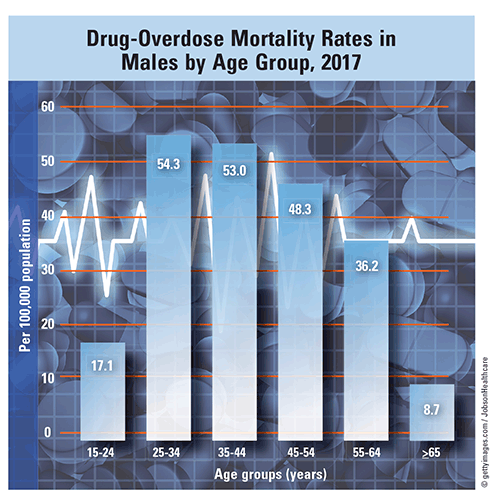US Pharm. 2020;45(6):12.
CDC data have revealed increases in drug-overdose deaths among men, primarily involving synthetic opioids other than methadone. Mortality rates for drug overdose are consistently higher among males. Fentanyl-related deaths have increased significantly, and three times more males than females are dying from synthetic-opioid use.

Rates by Age Group: According to the National Center for Health Statistics’ 2018 report, of every 100,000 males, 29.1 died from drug overdose. The mortality rate was highest (54.3) in men aged 25 to 34 years and decreased with age: 53 in those aged 35 to 44 years, 48.3 in those aged 45 to 54 years, and 36.2 in those aged 55 to 64 years. The rate among men aged 65 to 74 years (11.8) was one-fifth of its peak at ages 25 to 34 years. The mortality rate increased threefold between ages 15 to 24 years and ages 25 to 34 years but declined gradually with age.
Rates by Race and Drug Type: Drug-overdose mortality rates per 100,000 males differed according to race. The rate in non-Hispanic whites was 16.2% higher than that for non-Hispanic blacks (35.8 vs. 30.8). The rates in Hispanic (15.9) and American Indian males (19.7) were three and four times higher, respectively, than that for Asians/Pacific Islanders (5.2). For males of different racial/ethnic backgrounds, opioids (67.9) had the highest mortality rate, followed by synthetic opioids other than methadone (42.2), natural and other semisynthetic opioids (16.7), and methadone (4.4). Overdose mortality rates from these four drugs were highest in non-Hispanic whites (51.3), 25% lower in non-Hispanic blacks (38.1), and 42% lower in American Indians (22.2); Hispanics had the lowest overdose mortality rate (19.6). Men outnumbered women more than twofold (3.4/100,000) in the rate of deaths from overdose of psychostimulants with abuse potential.
Rate Changes From 2017 to 2018: Although the mortality rate in males decreased for prescription opioids and heroin, it increased for synthetic opioids other than methadone. Prescription opioid–involved rates decreased in males by 13.1%; by age group, rates decreased by 25%, 16%, and 10.1%, respectively, for ages 15 to 24 years, 25 to 34 years, and 45 to 64 years. The rate for heroin decreased 2.7% overall; by age group, rates were 21.3% for ages 15 to 24 years, 2.7% for ages 25 to 44 years, and 1.1% for ages 45 to 64 years. However, for synthetic opioids other than methadone, there was an increase from 13/100,000 to 14.2/100,000 males; the increase was 8.1%, 11.4%, and 2.7%, respectively, for ages 15 to 24 years, 25 to 44 years, and 45 to 64 years.
The content contained in this article is for informational purposes only. The content is not intended to be a substitute for professional advice. Reliance on any information provided in this article is solely at your own risk.
To comment on this article, contact rdavidson@uspharmacist.com.






